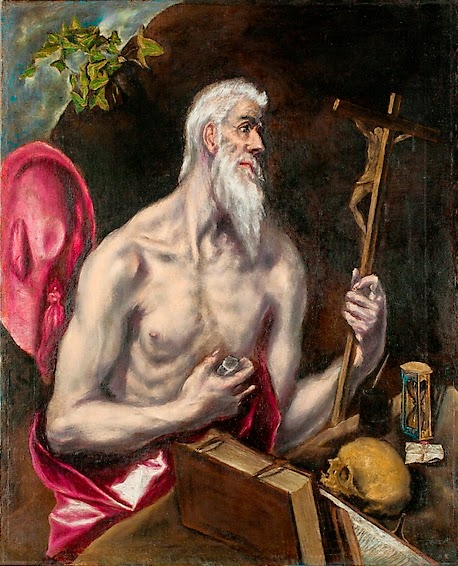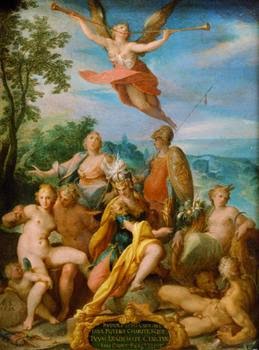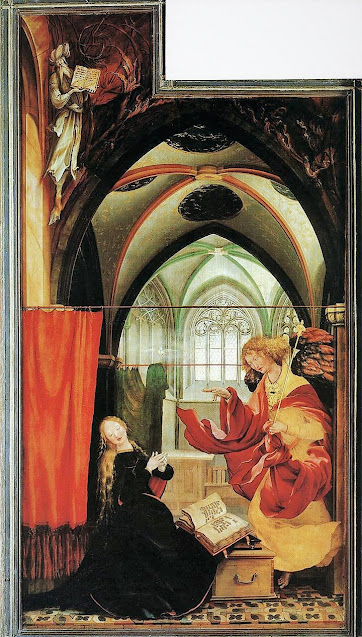 |
| El Greco, View of Toledo Greco-Spanish, 1597-1599 New York, Metropolitan Museum of Art |
About two months ago I wrote an article outlining the amazing
array of offerings in the museums of New York City available between the
beginning of November and the end of January.
The distractions of two bouts of bronchitis and the flurry of activity
surrounding Christmas and New Year, plus my concentration on researching and
writing my still unfinished articles about the Joyful Mysteries of the Rosary
meant that I didn’t take the time to properly review and recommend any of those
exhibitions.
This is unfortunate,
especially in the case of the recently closed exhibition of the paintings and
tapestries of Pieter Coecke van Aelst.
That was a simply spectacular show, which ended with a weekend devoted
to a scholarly symposium on Coecke and his period, part of which I
attended.
 |
| El Greco, St. Luke Greco-Spanish, ca. 1600-1605 New York, Hispanic Society of America |
However, several of the exhibitions are still open, at least through next Sunday, February 1, and two in particular are not to be missed if possible.
The Met will close two important exhibitions on February
1.
 |
| El Greco, Holy Family Greco-Spanish, ca. 1585 New York, Hispanic Society of America |
The first is a lovely little show of the El Grecos in the Met’s own collection, including the two usually seen only in the Lehman wing, reminding us once again of the depth of the Met's holdings. These are supplemented by several paintings from the little known collections of the Hispanic Society of America, which is located in a corner of Manhattan (at Broadway and 155th Street) not usually visited by tourists and seldom even by New Yorkers. Indeed, I myself visited it for the first time only two years ago.
The paintings from the Hispanic Society make a welcome
addition to round out the Met’s familiar holdings. They include a lovely Holy Family, featuring
a very substantial Baby Jesus, a sensitive St. Luke and a Penitent St. Jerome
which provides a nice pendant to the Met’s St. Jerome as a Cardinal from the
Lehman Collection.
 |
| El Greco, Penitent St. Jerome Greco-Spanish, c. 1600 New York, Hispanic Society of America |
 |
| El Greco, St. Jerome Greco-Spanish, 1600-1614 New York, Metropolitan Museum of Art, Lehman Collection |
But, the star among the Hispanic Society pictures, as far as I am concerned, is a beautiful head of St. Francis of Assisi.
 |
| El Greco, St. Francis of Assisi Greco-Spanish, ca. 1590 New York, Hispanic Society of America |
As the Met notes,
the St. Francis head has been cut from a much larger canvas, one of the myriad
paintings of St. Francis that came from the studio of the master. But the head itself is so beautifully painted
that it is probably from the hand of El Greco himself. And, happily, it does not really suffer from
its cut out state. Instead, the profile
view, seen against a black background produces almost the effect of a
sculptural profile bust. The effect is
startling and very impressive. The
reproduction at left does not do it justice.
You should see it if you can.
It should also be noted that the Frick is also running a
small complementary exhibition of its own three El Greco paintings. This will also close on February 1.
 |
| Bartholomeus Spranger, Self-Portrait Belgian, c.1585 Vienna, Kunsthistorisches Museum |
The second exhibition that warrants viewing at the Met
called Bartholomeus Spranger: Splendor and Eroticism in Imperial Prague.
Like
Coecke van Aelst, Spranger was an artist from a period of time and an area of Europe little known to American museum goers -- the later Northern Renaissance and Mannerist periods. In the last ten years the Met has presented
three shows devoted to the work of artists from this time and place. The first, in the autumn of 2010, was of the
work of Jan Gossart (sometimes known as Mabuse). The second and third are the two
recent/current exhibitions of Coecke van Aelst and Spranger.
All three men originated in the Belgian town of Antwerp, but had their success in other locations and under the patronage of members of the Burgundian Hapsburg royal family. All three were extremely important in blending the art of the earlier Northern Renaissance artists, with their near miraculous oil painting techniques, and the classical art of the Italian Renaissance during that interesting and still not quite understood period known as Mannerism, with its exaggerated forms and complicated compositions. All three started out as painters, but created some of their most interesting and important work as designs for tapestries, stained glass, gold work, engravings and other "minor arts" to be executed by others.
All three men originated in the Belgian town of Antwerp, but had their success in other locations and under the patronage of members of the Burgundian Hapsburg royal family. All three were extremely important in blending the art of the earlier Northern Renaissance artists, with their near miraculous oil painting techniques, and the classical art of the Italian Renaissance during that interesting and still not quite understood period known as Mannerism, with its exaggerated forms and complicated compositions. All three started out as painters, but created some of their most interesting and important work as designs for tapestries, stained glass, gold work, engravings and other "minor arts" to be executed by others.
 |
| Bartholomeus Spranger, Lamentation of the Dead Christ Belgian, c. 1576 Munich, Bayerisches Staatsgemaeldiesammlungen |
Of the three, Spranger is the youngest. Spranger received his initial training
in Antwerp, then went on to work in Italy at Parma as an assistant to the painter Bernardino Gatti and, most importantly, in Rome
where he worked with the artist Giulio Clovio in service to Cardinal Alessandro
Farnese and to Pope Pius V. After the
death of Pope Pius he moved on to the service of the Emperor Maximilian II at Vienna
(from 1575) and then to the service of Rudolf II at Prague, beginning in
1580.
He remained in Prague for most of the rest of his life, dying there in 1611.
All these movements and parts of his life are displayed in the three rooms of the exhibition, including a modern interpretation of what a portion of the Kunstkammer of Rudolf II might have resembled: combining paintings, drawings, prints, animal skeletons (on loan from the American Museum of Natural History across Central Park), ivory carvings and other curiosities into one grand display.
Like Arcimboldo, about whom I have written previously, Spranger’s paintings easily fit right into this type of display.
 |
| Bartholomeus Spranger, Odysseus and Circe Belgian, ca. 1580-1582 Vienna, Kunsthistorisches Museum |
 |
| Bartholomeus Spranger, God the Father with The Holy Spirit and Angels Belgian, ca. 1582 Vienna, Kunsthistorisches Museum |
He remained in Prague for most of the rest of his life, dying there in 1611.
All these movements and parts of his life are displayed in the three rooms of the exhibition, including a modern interpretation of what a portion of the Kunstkammer of Rudolf II might have resembled: combining paintings, drawings, prints, animal skeletons (on loan from the American Museum of Natural History across Central Park), ivory carvings and other curiosities into one grand display.
 |
| Partial view of the Met's installation reproducing the Kunstkammer of Rudolf II The large painting is Spranger's Jupiter and Antiope of about 1596 from the Kunsthistorisches Museum in Vienna |
Like Arcimboldo, about whom I have written previously, Spranger’s paintings easily fit right into this type of display.
Like his fellow Mannerists Spranger’s oeuvre mixes Christian religious scenes with allegories and with stories of the doings of the pagan gods of antiquity, depending on the taste and requirements of the patron for whom he worked.
 |
| Bartholomeus Spranger, Adoration of the Kings Belgian, ca. 1595 London, National Gallery |
 |
| Bartholomeus Spranger, Vanitas Belgian, ca. 1600 Krakow, Wawel Castle |
Many of the objects in the exhibition come from the Kunsthistorisches Museum and the Albertina in Vienna and from other collections in Germany, Hungary, the Czech Republic, Romania, Poland and Liechtenstein. For this reason alone the show is worth seeing and even more rewarding when seen as part of the wider European phenomenon of Mannerism that is represented by Spranger, Coecke van Aelst and Gossart in the north, by the artists of the School of Fontainebleau in France, El Greco in Spain and the Italian Mannerists like Rosso, Pontormo, Parmigianino, Giulio Romano, Vasari and others in Italy.
 |
| Bartholomeus Spranger, Noli Me Tangere Belgian, ca. 1590-1600 Bucharest, National Museum of Art of Romania |
 |
| Bartholomeus Spranger, Angelica and Medoro Belgian, ca. 1600 Munich, Alte Pinakothek |
 |
| Bartholomeus Spranger, Venus at the Forge of Vulcan Belgian, ca. 1610 Vienna, Kunsthistorisches Museum |
© M. Duffy, 2015
























